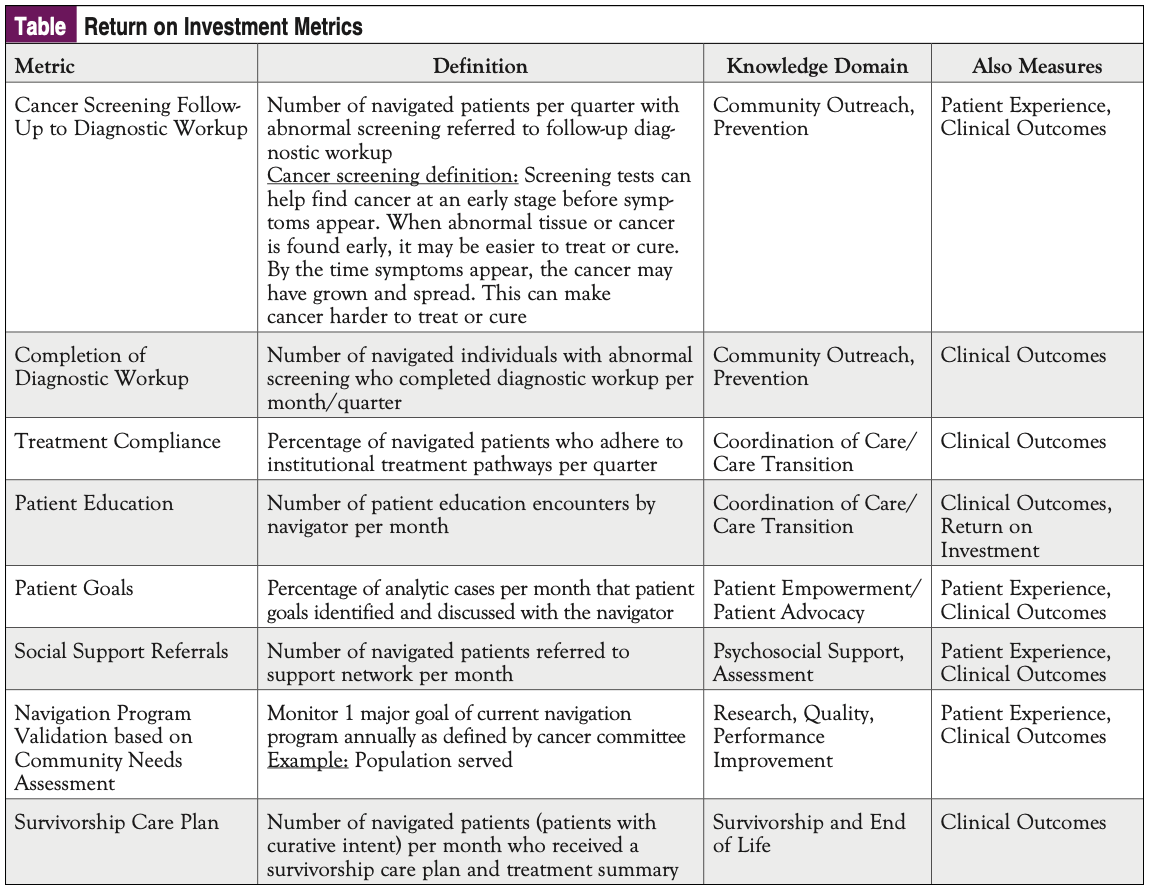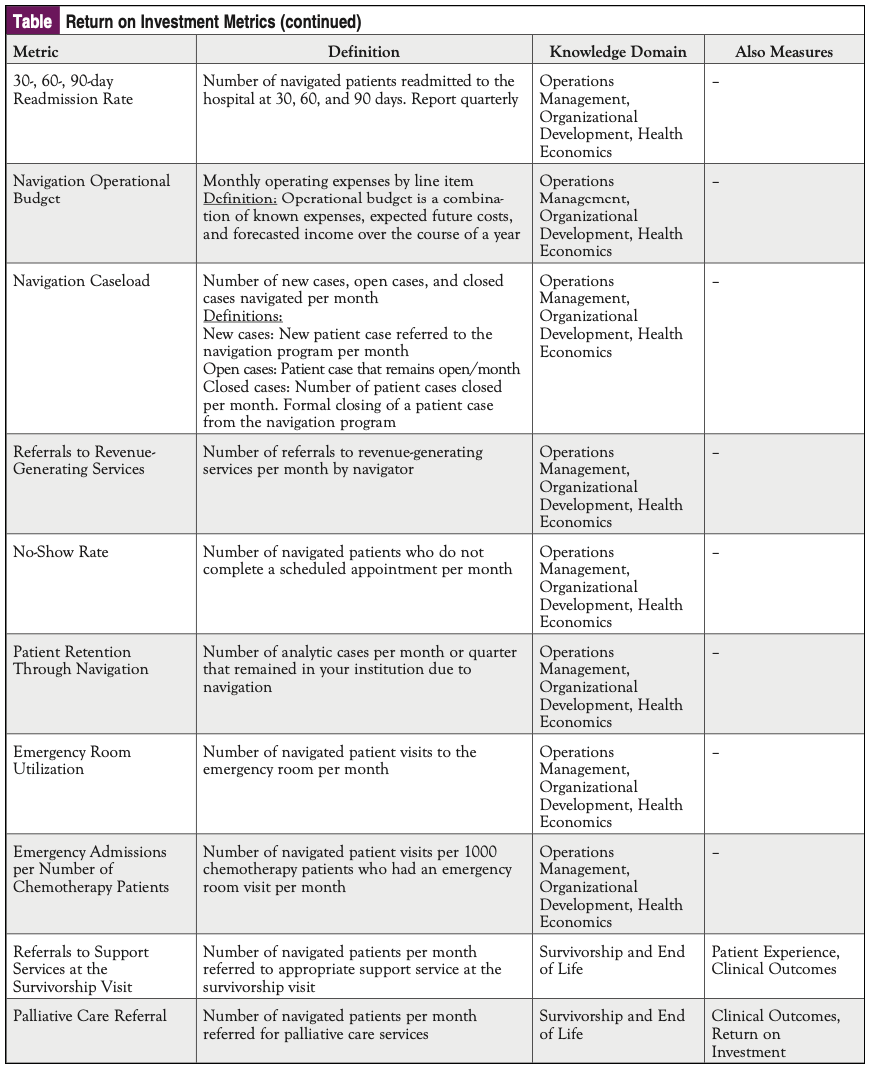When we think of ways to evaluate a navigation program, the first 2 topics that typically come to mind are measurements of clinical outcomes and the patient experience. Equally important is the return on investment (ROI) of the navigation program itself. Business performance metrics, unlike clinical outcomes or patient experience, are much less familiar to navigators. Yet, this category is becoming increasingly important as cancer program administrators evaluate the ROI of navigation services. The knowledge domain of Operations Management separates the navigator role from an oncology nurse who works in the silo of an infusion center, or in radiation, or inpatient care. The “operations” view tracks patients along the continuum, records steps to reduce barriers, ensures that cancer care meets standards of care, such as the National Comprehensive Cancer Network guidelines, and documents overall improvements in efficiency for the patient as well as the healthcare system. For this reason, the Academy of Oncology Nurse & Patient Navigators (AONN+) created metrics specific to ROI as a method for measuring navigation success.
The AONN+ Standardized Metrics are organized into 8 domains of knowledge and designed to measure clinical outcomes, return on investment, and patient experience. AONN+ encourages its members to measure ROI as a means to monitor the success of their navigation program. In this article, we present the AONN+ metrics that are specific to the ROI for navigation services. For more information on the AONN+ metrics, please visit www.AONNonline.org.
There are up-front costs for implementing a patient navigation program. However, several studies demonstrate a payoff as ROI. Following are examples of the metrics.
The “no-show metric” was demonstrated by the MetroHealth Cancer Center in Ohio.1 This institution initiated a year-long pilot employing 2 full-time navigators to decrease the patient no-show rate. A navigator’s annual salary was comped in 3 months, as the reduction in no-shows for patients receiving radiation therapy equaled this amount. High-risk hospital admissions were reduced by half, and readmissions and emergency room visits declined by a third. The overall ROI was $5 for every $1 spent.
The Patient Education metric was validated in 2014 by Intermountain Southwest Cancer Center in Utah when they showed an annual cost saving of $277,953 by medical oncologists as they experienced a 24-minute reduction in clinical visit time with a newly diagnosed patient with breast cancer when the patient had received an educational visit with a nurse navigator prior to meeting with the oncologist.2 This allowed the medical oncologist to see 1 additional new clinic patient each day. The additional revenue generated by 4 oncologists seeing 1 new patient per day was $207,360, and this in addition to the annual costs savings had the potential to bring in $485,312 to the system annually. This more than covered the salary of a nurse navigator and an additional navigator.
The “Patient Retention Through Navigation” was highlighted at Henrico Doctors’ Hospital when this system used a gap analysis to recognize the need for a nurse navigator to be placed earlier in the breast continuum. This change decreased the breast patient outmigration rate from 240 to 28, and the budgetary impact to the system was $350,000 in billable services or procedures in 1 year.3 When they expanded the role from point of suspicious finding and diagnosis to the entire care continuum of navigation (treatment to survivorship), the consistency this one person had from gaining trust and credibility with patients at a vulnerable time equaled a $3000 greater contribution margin per patient downstream analysis.
Measuring the ROI of navigation services demonstrates the value your navigation program brings to your institution. These metrics give you the ability to provide evidence of that value. It is our sincere hope that you will select several of these metrics, track the results, and submit your findings to AONN+ as well as to the administrators of your institution. Together, we can show the value of navigation services, enrich the literature with our findings, and learn best practices from each other.
References
- Managed Healthcare Executive. Navigators reduce no-shows. www.man agedhealthcareexecutive.com/view/navigators-reduce-no-shows. 2013.
- Christensen D, Bellomo C. Using a nurse navigation pathway in the timely care of oncology patients. Journal of Oncology Navigation & Survivorship. 2014;5(3):13-18.
- Desimini EM, Kennedy JA, Helsley MF, et al. Making the case for nurse navigators. Oncology Issues. www.accc-cancer.org/oncology_issues/articles/SO11/SO11-Making-the-Case-for-Nurse-Navigators.pdf.





